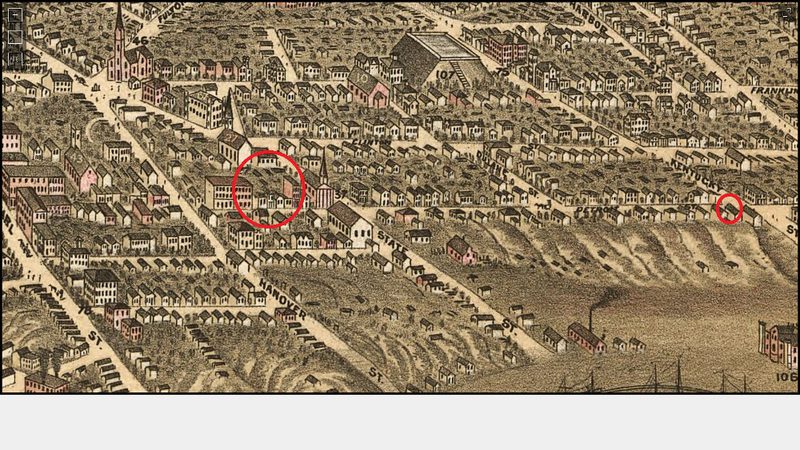Alexander Kimberley House
The Grand Italianate House Built by a Saloon Keeper

Located on the south end of the Stockyards neighborhood of mostly working-class homes, the two story brick Italianate-style house at 7403 Denison Avenue stands out, especially because of its cupola and intricate balustrade craftsmanship. Built in 1866 for Alexander Kimberley, the house is not only one of the oldest in the neighborhood, but it is also one of the neighborhood's few remaining houses of this type of architectural design.
Who was Alexander Kimberley, you might ask? He was not an early Cleveland industrialist like James Farnan who with his family's brass factory wealth built a similarly beautiful Italianate home in the Detroit-Shoreway neighborhood (see Cleveland Historical story: "The House that Brass Built"). Nor was he a large-scale real estate developer like Benjamin Tyler who could easily afford his elegant Italianate summer home on the north end of the Stockyards neighborhood (see Cleveland Historical story: "B. F. Tyler House"). While neither a James Farnan nor a Benjamin Tyler, Alexander Kimberley still found a path to moderate wealth in mid-nineteenth-century Cleveland, one that enabled him to build the beautiful house that is the subject of this story. It's a house which has now stood on the top of the ridge at Denison Avenue and West 73rd Street for more than 150 years.
So how did he do it? Alexander Kimberley was an immigrant from Birmingham, England. When he arrived in Cleveland in 1846 as a nineteen year old boy, the city was just beginning its transition from commercial hub to industrial powerhouse. In the 15-year period from 1845-1860, the urban population exploded from 14,000 to 44,000, a more than 300% increase. Alexander Kimberley decided to make his money by serving that growing population. He began by operating saloons. By 1852, he had opened his first, near the docks at the foot of Superior Street. Three years later, partnering with his younger brother Frederick, he opened a second, this one on Public Square, across from where the County Court House sat at the time. Perhaps he intended this saloon to serve a more genteel clientele than the first. The brothers advertised that their "Arcade Dining Saloon" would feature an "Eating House on the European Plan." In 1857, Kimberley, now thirty years old, capped off his saloon entrepreneurship by opening a third saloon--this one he called a restaurant--on Merwin Street, near West Street, not far from where the Flat Iron cafe sits today on the east bank of the Flats.
There are no records extant to tell us exactly how much money Kimberley made from these three saloons, but it must have been substantial. And, like many of the lower socio-economic classes who began to make money in Cleveland's growing mid-nineteenth-century economy, Kimberley decided to invest in real estate in Ohio City, which soon merged with Cleveland to become the latter city's west side. He purchased a house on Detroit Street just east of Kentucky (W. 38th) Street in 1853, living there and operating a millinery store out of the first floor. In 1859, he made his second investment, a commercial lot on Detroit near Hanover (W. 28th) Street. By the time the 1860 census arrived, Alexander Kimberley was no longer a saloon keeper. It is likely that when the census-taker asked what his profession or trade was, Kimberley responded with some pride, "I am a merchant."
In 1864, Alexander Kimberley purchased eighteen acres of land on the south side of Ridge Road (now Denison Avenue) in what was then Brooklyn Township from Rufus K. Winslow, one of the founders of the Academy of Natural Sciences, later known as the Cleveland Museum of Natural History. The land lay about two and one-half miles southwest of Kimberley's home on Detroit Street. By this time, he was married and the father of two children. Within two years' time, construction of the ornate house in the country which is the subject of this story was completed and the family moved in. When the 1870 census was taken four years later, Kimberley stated that he was now a farmer--most likely a gentleman farmer, because he continued to operate his millinery store in town and invest in real estate in the Detroit Street area of the near west side. Among his most significant projects was the development in 1873 of a commercial building complex on the south side of Detroit Avenue between Hanover (W. 28th) and State (W. 29th) Streets, which he built in partnership with his brother David. The complex featured a number of retail store fronts, two meeting halls, and one building known as the Kimberley Block.
Alexander Kimberley died in 1885 after suffering a stroke. The Italianate house at 7403 Denison was sold a few years later to immigrants from Germany, the Ernst Stern family. The Sterns lived in the house until 1916, when it was sold to a building supply company that used the home as an office. Ever since, the property has been used for commercial purposes, although as late as 1940, the second floor of the house was leased to renters. Most recently, the grand old house served as the home of a waffle house and ice cream store.
Images











